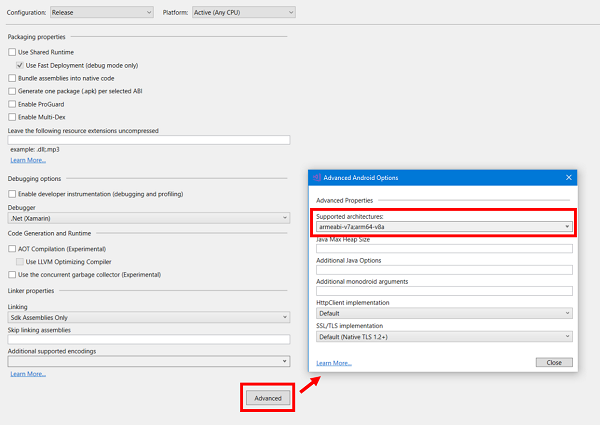CPU Architectures
Xamarin.Android supports several CPU architectures, including 32-bit and 64-bit devices. This article explains how to target an app to one or more Android-supported CPU architectures.
CPU Architectures Overview
When you prepare your app for release, you must specify which platform CPU architectures your app supports. A single APK can contain machine code to support multiple, different architectures. Each collection of architecture-specific code is associated with an Application Binary Interface (ABI). Each ABI defines how this machine code is expected to interact with Android at run time. For more information about how this works, see Multi-Core Devices & Xamarin.Android.
How to Specify Supported Architectures
Typically, you explicitly select an architecture (or architectures) when your app is configured for Release. When your app is configured for Debug, the Use Shared Runtime and Use Fast Deployment options are enabled, which disable explicit architecture selection.
In Visual Studio, right-click on your project under the Solution Explorer and select Properties. Under the Android Options page check the Packaging properties section and verify that Use Shared Runtime is disabled (turning this off allows you to explicitly select which ABIs to support). Click the Advanced button and, under Supported architectures, check the architectures that you want to support:
Xamarin.Android supports the following architectures:
- armeabi – ARM-based CPUs that support at least the ARMv5TE instruction
set. Note that
armeabiis not thread-safe and should not be used on multi-CPU devices.
Note
As of Xamarin.Android 9.2, armeabi is no longer supported.
armeabi-v7a – ARM-based CPUs with hardware floating-point operations and multiple CPU (SMP) devices. Note that
armeabi-v7amachine code will not run on ARMv5 devices.arm64-v8a – CPUs based on the 64-bit ARMv8 architecture.
x86 – CPUs that support the x86 (or IA-32) instruction set. This instruction set is equivalent to that of the Pentium Pro, including MMX, SSE, SSE2, and SSE3 instructions.
x86_64 CPUs that support the 64-bit x86 (also referred as x64 and AMD64) instruction set.
Xamarin.Android defaults to armeabi-v7a for Release builds. This
setting provides significantly better performance than armeabi. If
you are targeting a 64-bit ARM platform (such as the Nexus 9), select
arm64-v8a. If you are deploying your app to an x86 device, select
x86. If the target x86 device uses a 64-bit CPU architecture, select
x86_64.
Targeting Multiple Platforms
To target multiple CPU architectures, you can select more than one ABI (at the expense of larger APK file size). You can use the Generate one package (.apk) per selected ABI option (described in Set Packaging Properties) to create a separate APK for each supported architecture.
You do not have to select arm64-v8a or x86_64 to
target 64-bit devices; 64-bit support is not required to run
your app on 64-bit hardware. For example, 64-bit ARM devices (such as
the Nexus 9) can run apps configured for
armeabi-v7a. The primary advantage of enabling 64-bit support is to
make it possible for your app to address more memory.
Note
From August 2018 new apps will be required to target API level 26, and from August 2019 apps will be required to provide 64-bit versions in addition to the 32-bit version.
Additional Information
In some situations, you may need to create a separate APK for each architecture (to reduce the size of your APK, or because your app has shared libraries that are specific to a particular CPU architecture). For more information about this approach, see Build ABI-Specific APKs.

